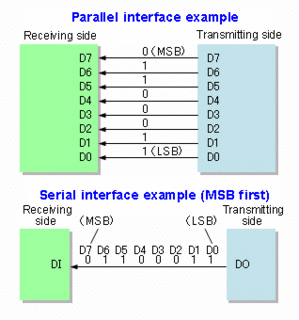
A cliffhanger, or cliffhanger ending, is a plot device in fiction which features a main character in a precarious or difficult dilemma, or confronted with a shocking revelation at the end of an episode of serialized fiction. A cliffhanger is hoped to ensure the audience will return to see how the characters resolve the dilemma.
In computer science, a parallel algorithm, as opposed to a traditional serial algorithm, is an algorithm which can be executed a piece at a time on many different processing devices, and then combined together again at the end to get the correct result.

Low-voltage differential signaling, or LVDS, also known as TIA/EIA-644, is a technical standard that specifies electrical characteristics of a differential, serial communications protocol. LVDS operates at low power and can run at very high speeds using inexpensive twisted-pair copper cables. LVDS is a physical layer specification only; many data communication standards and applications use it and add a data link layer as defined in the OSI model on top of it.

In telecommunication and data transmission, serial communication is the process of sending data one bit at a time, sequentially, over a communication channel or computer bus. This is in contrast to parallel communication, where several bits are sent as a whole, on a link with several parallel channels.
In information technology and computer science, especially in the fields of computer programming, operating systems, multiprocessors, and databases, concurrency control ensures that correct results for concurrent operations are generated, while getting those results as quickly as possible.
In database systems, isolation determines how transaction integrity is visible to other users and systems. For example, when a user is creating a Purchase Order and has created the header, but not the Purchase Order lines, is the header available for other systems/users to see?
In the fields of databases and transaction processing, a schedule of a system is an abstract model to describe execution of transactions running in the system. Often is a list of operations (actions) ordered by time, performed by a set of transactions that are executed together in the system. If the order in time between certain operations is not determined by the system, then a partial order is used. Examples of such operations are requesting a read operation, reading, writing, aborting, committing, requesting a lock, locking, etc. Not all transaction operation types should be included in a schedule, and typically only selected operation types are included, as needed to reason about and describe certain phenomena. Schedules and schedule properties are fundamental concepts in database concurrency control theory.

In firearms terminology, the firearm receiver or firearm frame is the part of a firearm which provides housing for internal components such as the hammer, bolt or breechblock, action and firing mechanism, and is usually threaded at its forward portion to "receive" the barrel and has screw holes on the bottom and/or rear to receive the stock and grip. The receiver is often made of forged, machined, or stamped steel or aluminium; in addition to these traditional materials, modern science and engineering have introduced polymers and sintered metal powders to receiver construction.
In computing, an interface is a shared boundary across which two or more separate components of a computer system exchange information. The exchange can be between software, computer hardware, peripheral devices, humans, and combinations of these. Some computer hardware devices, such as a touchscreen, can both send and receive data through the interface, while others such as a mouse or microphone may only provide an interface to send data to a given system.

The Pawns of Null-A is a 1956 science fiction novel by A. E. van Vogt originally published as a four-part serial in Astounding Stories from October 1948 to January 1949 as The Players of Null-A. It incorporates concepts from the General semantics of Alfred Korzybski and refers to non-Aristotelian logic. It was published in the UK with the original name.
The serial shipping container code (SSCC) is an 18-digit number used to identify logistics units. In order to automate the reading process, the SSCC is often encoded in a barcode, generally GS1-128, and can also be encoded in an RFID tag. It is used in electronic commerce transactions.
A Serializer/Deserializer is a pair of functional blocks commonly used in high speed communications to compensate for limited input/output. These blocks convert data between serial data and parallel interfaces in each direction. The term "SerDes" generically refers to interfaces used in various technologies and applications. The primary use of a SerDes is to provide data transmission over a single line or a differential pair in order to minimize the number of I/O pins and interconnects.
In television and radio programming, a serial has a continuing plot that unfolds in a sequential episode-by-episode fashion. Serials typically follow main story arcs that span entire television seasons or even the full run of the series, which distinguishes them from traditional episodic television that relies on more stand-alone episodes. Worldwide, the soap opera is the most prominent form of serial dramatic programming.

The Weapon Makers is a science fiction novel by Canadian writer A. E. van Vogt.
Seriality or serial collectivity is a term that feminist scholar Iris Marion Young used to describe a reconceptualization of the category of woman in her 1994 essay Gender as Seriality. Young borrows the concept of seriality from Sartre's Critique of Dialectical Reason, where he originally developed the idea to describe the relationship of individuals to social classes and the capitalist system of production and consumption. Understanding women as a series, rather than a group, entails the recognition that the category woman is not defined by any common biological or psychological characteristics; rather, individuals are positioned as woman by a set of material and immaterial social constructs that are the product of previous human actions.
Drug distribution is the process by means of which people get access to medication.






